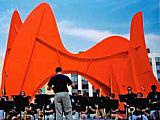
La Grande Vitesse
GRHC - June 2nd, 2010
As Festival of the Arts returns to Grand Rapids, enjoy the story of our downtown landmark.
Transcript
When Nancy Mulnix attended a lecture at the Grand Rapids Art Museum in April of 1967 she had little idea of its implications for the city. Following the event Mulnix gave the speaker, a curator from the Metropolitan Museum of Art in New York, a tour of downtown, including the area where construction of the Vandenberg Center was about to replace the effects of urban renewal.
The gentleman suggested placing a work of public art in the space. Mulnix liked the idea and wrote to Congressman Gerald R. Ford to ask for his help in obtaining grant funding. Ford followed through even though politically he had been against the new program, the National Endowment for the Arts.
A Sculpture Committee, including Peter Wege as Co-Chair with Mulnix, was formed as well as a separate group of six local and national art experts who selected the artist, Alexander Calder. Mulnix met Calder for the first time at Dec. 1967 at Perls Gallery in New York City. They became close friends during the project and continued visits and correspondence until Calder’s death in 1976.
The efforts of Mulnix resulted in the creation of La Grande Vitesse, fondly referred to as the Calder, which became the first sculpture in the United States to be supported with public funds for the arts. It was a controversial piece at its inception and criticized by many in the community, but it quickly became a focal point of downtown and a symbol of the city.
Full Details
| Title | La Grande Vitesse |
|---|---|
| Creator | GRHC |
| Keywords | Glance at the Past; history; La Grande Vitesse; Alexander Calder; Gerald Ford; WYCE; Grand Rapids; Historical Commission |
| Duration | 2:05 |
| Pubdate String | June 2nd, 2010 |

 facebook
facebook